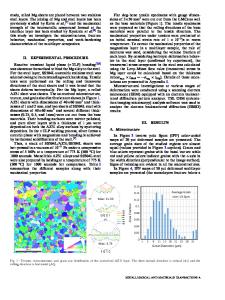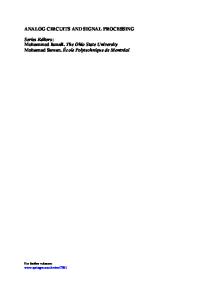Synthesis and Electronic Properties SWCNT Sheets
- PDF / 381,304 Bytes
- 6 Pages / 612 x 792 pts (letter) Page_size
- 71 Downloads / 350 Views
1081-P06-09
Synthesis and Electronic Properties SWCNT Sheets David Lashmore, Brian White, Mark Schauer, and Jenn Mann R&D, Nanocomp, 162 Pembroke, Concord, NH, 03301 ABSTRACT The electronic properties of carbon nanotube sheets and yarns suggest important commercial applications for aerospace and civilian markets exist for these types of materials. Carbon nanotube yarns are one of the few non-metallic materials that have the potential to replace copper for both heat transport and for electrical conduction. Nanocomp has demonstrated, for the first time that the resistivity for yarns and sheet conductors can have values similar to those already published for individual CNTs or about 2 x 10-4 ohm-cm, and achieve this conductivity at 1/8th the mass. The high frequency characteristics of CNT conductors are superior to copper at frequencies as low as a few MHz. In this paper we describe: (1) A means of producing electrically conductive yarns and sheets in commercial volume, (2) Describe direct current electrical conductivity, (3) Present unique conductor geometries and finally (4) Discuss applications for CNT sheets as electrical conductors, for flexible connectors, lightning protection, and for EMI shielding. INTRODUCTION Copper based wire conductors, with an 8.9 g/cc density, are used because of copper’s electrical conductivity and low cost. However for some applications where considerations of weight, oxidation resistance, strength, or fatigue are concerned; copper wire has serious performance deficiencies. Examples include the automotive industry where increasing power demands are forcing a change from 14-volt to 42-volt architectures [1] because of cost and weight; similar considerations exist in the aerospace industry [2]. This increase affects generators, alternators, solenoids and radar, along with the power cables connecting these systems. In some of these these applications currents are pulsed, so eddy currents are generated, and together with proximity effects combine to affect current rise times and impedance. Existing flexible copper wire connectors can undergo static fatigue (creep) or vibration fatigue. Additionally the high temperatures surrounding generators or alternators (attached to the jet engine gear box) can subject copper wire to degradation by oxidization. Copper windings for motors and generators add weight and generate significant Joule heating within the windings, and this, along with eddy current induced heating in the adjacent magnetic circuits, may cause these devices to run hot. Replacing copper conductors with a nanotube “Litz” wire may offer a very significant weight savings, immunity to fatigue, heat resistance, and very high current carrying capacity. Further, at high frequency, CNT cables may offer lower impedance than equivalent copper CNT cables.
EXPERIMENT SWCNT Wires Carbon nanotube wires are spun from CNTs produced by a CVD process that can be tailored to grow single or multiwall CNTs. This gas phase pyrolysis process has been described by many others [3-9] and briefly consists
Data Loading...









